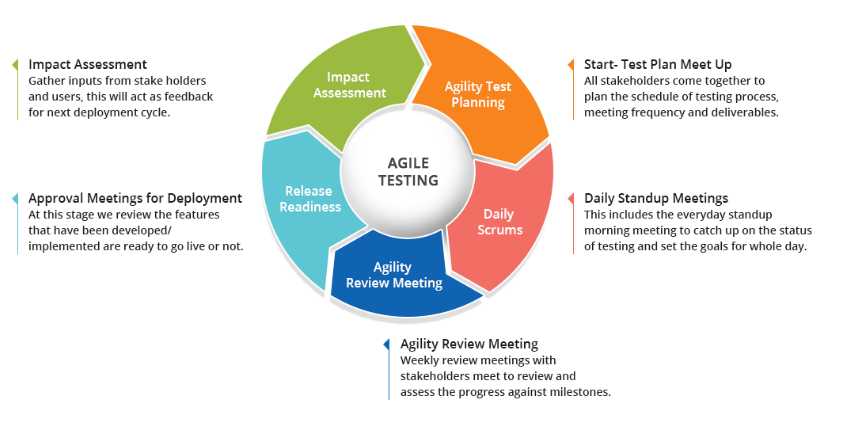Agile testing is a software testing method where the testing is intertwined with the web development process, ie, it is deployed while the code is still in the making, and not when the coding is complete. Hence, agile testers are an active part of the process and are functional in bridging the gap between the product owners’ expectations, developers’ execution of the code and the feedback of the end users.
Traditionally, the waterfall method for testing has been in use. Waterfall testing begins only when the development phase is over, with developers and testers working separately to improve on the code. The testing process is structured and planned extensively before being deployed, as any change in the software translates to the project being started from the beginning again.
In comparison, this is how agile testing works.
The Principles of Agile Testing
Agile development methodology, agile analytics and the Scrum framework have been very influential over the years. As the name suggests, agile testing is bringing agile to the process of testing. It is involved not in the feedback phase of a product but in its very execution. This is what the life cycle of an agile testing process looks like -

Following are some principles on which agile testing functions.
-
Continuous testing
Agile testing is based on the thought of verification before final execution, hence there always is an ongoing mechanism to test each component of the development process in every step as you go instead of waiting for the process to end. Continuous testing ensures that there are no major blunders incoming in the future.
-
Team involvement
As testing goes alongside the coding process, developers and testers work together as a team, continuously feeling involved in the project. Working while also verifying the code at the same time calls for greater accountability by the individuals involved, and adds to the speed of product delivery by cancelling the time it would normally take for the product to do rounds of testing and analysis before landing the market. Teamwork is hence practised and also adequately rewarded at the end. For efficient team collaboration, learn how to leverage agile practices with JIRA and build a diverse and inclusive team with agile techniques.
-
Prompt Feedback
With analysts also involved in the same development loop, constant examination of the code is going on in the backdrop. Problems are hence immediately detected and fixed needing no extra time and delegation by the owner. In the traditional method, the time between finishing the code and starting the testing phase can span from weeks to months, but that’s not the case with agile as one is given prompt feedback abode the code.
Hence, the resulting code is largely good to go, with only minor alterations expected, if any.
-
Less Documentation
Since agile testing is not a demarcated process, there is minimal documentation required. Something as simple as a checklist is good to go as well. An agile testing team focuses more on the present needs and feedback of the users to fix the code in real time instead of a detailed theoretical list of tentative issues. More about strategising agile documentation here.
-
Consumer Satisfaction
The core underlying principle in the whole process is optimum consumer satisfaction. In an age where instant gratification is associated with technology, agile testing provides the much needed leap to the process of coding in order to deliver the finished product to the audience as fast and error free as possible.
Agile Testing Techniques
There are several methods to conduct agile testing that are referred to in the process, irrespective of the underlying methodologies, including -
-
Test Driven Development
Test driven development initiates with deciding what is to be tested, ie, writing the unit test, and later going on to define the user story. Finally, the code is written. Automated testing tools are used for this method.
-
Acceptance Test Driven Development
ATDD involves different perspectives and ideas of the customer, the developer and the tester - the process beginning with the customer inputs on the functionality of the product. The development team then focuses on writing the code, and the testers look for probable bottlenecks that could arise at a later stage.
-
Behaviour Driven Development
Behaviour Driven Development is focused on the business aspect of the development, hence the scenarios, risks and bottlenecks are all analysed from a business perspective. BDD uses a set of 'Executable Specifications', ie, information about how a feature could act differently in different situations subject to the given inputs. An example of BDD works can be seen here through implementation of Behat.
-
Exploratory testing
In exploratory testing, the test planning and execution go on simultaneously, exploring the possible risks at hand and fixing them. In this method, the team is more inclined to learn by example rather than comprehensive documentation. As research goes on, the testers try to understand the application and execute the testing according to their discoveries.
Overcoming the Challenges
While agile testing does check a lot of boxes, there certainly are a bunch of challenges that come attached with such a high pace testing method. A few possible challenges you should prepare for are -
-
Lack Of Strategic Planning
While extensive documentation cannot be prepared for a dynamic act, strategic planning is required at every step in agile testing. The plan of action needs to be rigid enough to provide everyone a general sense of direction but at the same time be flexible enough to incorporate any changes that come along the way.
-
Ever changing requirements
The constant denominator in agile projects is change. Since development and discovery happens side by side, changes in management requirements are bound to happen keeping market needs in context. Thus, optimum communication among the team members also assumes prominent importance, as everyone needs to be on the same page about every stage of testing conducted or being planned.
-
Missing Information
Another segment of lack of proper communication is missing out on essential information. While a product owner might be aware of some market statistics, the person won't be well versed with the specifics involved in formulating a particular idea. If the requirements by the owner are not properly conveyed developers and testers would be at a loss as the vision for the end product would be different for both the parties involved.
To avoid this problem, proper information about the in-depth requirements must be given to the testers and the ideas for different scenarios should be discussed among the team and the product owner.
-
Technicalities
A bunch of technicalities need to be kept in mind while agile testing. Appropriate automation needs to be incorporated to save time in the process to save effort and time in manual labour, as in business terms, time is money. Cross browser testing while product development also cannot be ignored, as being multiple platform friendly is essential for enhanced user experience. All of this while keeping the pace up is essential, and any backlog should be avoided to prevent piling up of technical debt.
Talking of skills, agile testers need to be appropriately tech savvy. Having knowledge about API testing and integration testing is required, along with information about programming and scripting languages JavaScript and Ruby.
-
Improper Management
Micromanaging can become a huge problem in agile testing teams. Since the workflow is dynamic and is a continuous process trying to control the various aspects of the agile framework can do more harm than good. Agile teams are self organizing, hence the schedule and the pace of the team should be left to the members.
-
Unfamiliar methodologies
Some methodologies of the Agile Framework might be relatively new for the industry, and hence some team members might take some time to brush their skills. Any knowledge gap should be aptly addressed and consequently filled. If fundamental problems are left unaddressed, damage will be inevitable.
Conclusion
At the end, it all boils down to where your business stands and what your priorities are. For laid-back enterprises that have more or less static conduct, agile testing for software development might be unnecessary, while it might work great for corporates that are largely dynamic in nature and induce change in their working often.
Subscribe
Related Blogs
Trek n Tech Annual Retreat 2025: A 7-Day Workcation of OSL

OSL family came together for the Trek n Tech Annual Retreat 2025, a 7-day workcation set amidst the serene beauty of…
Exploring Drupal's Single Directory Components: A Game-Changer for Developers

Web development thrives on efficiency and organisation, and Drupal, our favourite CMS, is here to amp that up with its…
7 Quick Steps to Create API Documentation Using Postman

If you work with API , you are likely already familiar with Postman, the beloved REST Client trusted by countless…




